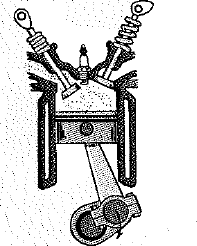
A mixture of fuel and air is burned rapidly in a combustion engine to push a piston in the engine that m turn propels the vehicle. In a jet engine, a mixture of fuel and air is burned rapidly and, instead of pushing pistons, pushes the aircraft itself. Which do you suppose is more efficient?

To explain: Whether combustion engine or an aircraft’s jet engine is more efficient.
Explanation of Solution
Introduction:
Efficiency is a term which is used to define the performance of the system. A system is called is more efficient when you receive maximum work and less waste. An internal − combustion engine is a type of heat engine which is used for the conversion of heat energy into the mechanical energy like the burning heat of gasoline into the torque.
In the engine the piston is pushed by the combustion engine due to the rapid burning of air fuel mixture. Whereas in jet engine, due to the rapid burning of air fuel the aircraft instead of piston. So, the engine of jet is more efficient than combustion energy because in combustion engine due to the piston pushing some energy is lost in friction.
Conclusion:
Hence, the jet engine will be more efficient.
Chapter 24 Solutions
Conceptual Physics C2009 Guided Reading & Study Workbook Se
Additional Science Textbook Solutions
Campbell Biology: Concepts & Connections (9th Edition)
Cosmic Perspective Fundamentals
Biology: Life on Earth with Physiology (11th Edition)
Microbiology: An Introduction
Physics for Scientists and Engineers: A Strategic Approach, Vol. 1 (Chs 1-21) (4th Edition)
College Physics: A Strategic Approach (3rd Edition)
- What fuel economy should be expected from a gasoline powered car that encounters a total of 443N of resistive forces while driving down the road? (Those forces are from air drag, rolling resistance and bearing losses.) Assume a 30% thermodynamic efficiency.arrow_forwardNo chatgpt pls will upvotearrow_forward12. What is the angle between two unit vectors if their dot product is 0.5?arrow_forward
- If the car in the previous problem increases its power output by 10% (by pressing the gas pedal farther down), at what rate will the car accelerate? Hint: Consider the net force. In the previous problem the power was 31.8kWarrow_forwardWhat power is required (at the wheels) for a 1400 kg automobile to climb a 4% grade at a constant speed 30 m/s while it is opposed by drag and rolling resistance forces totaling 500 N?arrow_forwardNo chatgpt pls will upvotearrow_forward
- As a box is lifted against gravity and placed on a shelf, how does the work done by the lifter compare with the work done by gravity? What is the net work done on the box? What does this imply about its change in kinetic energy? Use definitions and mathematics from this chapter to answer these questions.arrow_forwardAs I carry a box up a flight of stairs, am I doing positive work or negative work on the box? Provide a mathematical explanation.arrow_forwardAs a ball falls under the influence of gravity, does gravity do positive work or negative work? Provide a mathematical explanation.arrow_forward
- Under what circumstances is it bad to describe kinetic energy as k = 1/2mv^2arrow_forwardNo chatgpt pls will upvotearrow_forwardAir temperature of 37 °C increases swimming pool temperature of 2.55 °C. What is the fraction of the water in the pool must evaporate during this time to carry enough energy to keep the temperature of the pool constant? 4186 J/(kg°C) = specific heat of water 2,430,000 (2.43 x 106) J/kg = latent heat of vaporization for the water in the pool.arrow_forward
 College PhysicsPhysicsISBN:9781305952300Author:Raymond A. Serway, Chris VuillePublisher:Cengage Learning
College PhysicsPhysicsISBN:9781305952300Author:Raymond A. Serway, Chris VuillePublisher:Cengage Learning University Physics (14th Edition)PhysicsISBN:9780133969290Author:Hugh D. Young, Roger A. FreedmanPublisher:PEARSON
University Physics (14th Edition)PhysicsISBN:9780133969290Author:Hugh D. Young, Roger A. FreedmanPublisher:PEARSON Introduction To Quantum MechanicsPhysicsISBN:9781107189638Author:Griffiths, David J., Schroeter, Darrell F.Publisher:Cambridge University Press
Introduction To Quantum MechanicsPhysicsISBN:9781107189638Author:Griffiths, David J., Schroeter, Darrell F.Publisher:Cambridge University Press Physics for Scientists and EngineersPhysicsISBN:9781337553278Author:Raymond A. Serway, John W. JewettPublisher:Cengage Learning
Physics for Scientists and EngineersPhysicsISBN:9781337553278Author:Raymond A. Serway, John W. JewettPublisher:Cengage Learning Lecture- Tutorials for Introductory AstronomyPhysicsISBN:9780321820464Author:Edward E. Prather, Tim P. Slater, Jeff P. Adams, Gina BrissendenPublisher:Addison-Wesley
Lecture- Tutorials for Introductory AstronomyPhysicsISBN:9780321820464Author:Edward E. Prather, Tim P. Slater, Jeff P. Adams, Gina BrissendenPublisher:Addison-Wesley College Physics: A Strategic Approach (4th Editio...PhysicsISBN:9780134609034Author:Randall D. Knight (Professor Emeritus), Brian Jones, Stuart FieldPublisher:PEARSON
College Physics: A Strategic Approach (4th Editio...PhysicsISBN:9780134609034Author:Randall D. Knight (Professor Emeritus), Brian Jones, Stuart FieldPublisher:PEARSON





